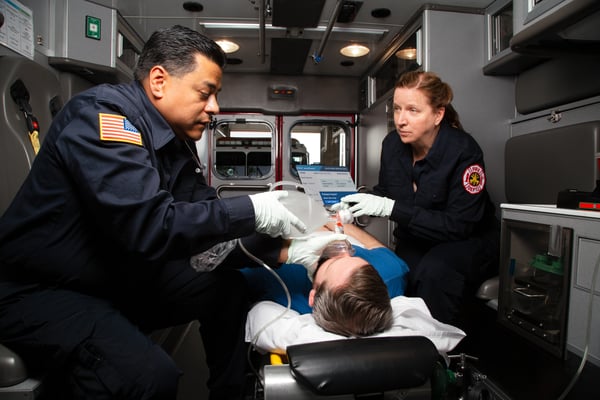News Alert: New ePCR Integration Simplifies EMS Data Management and Enables Better Care Coordination
Now Is the Time to Make the Transition to Electronic Charting

N.Y. State 2022 CME Recertification Requirements Signal Shift Toward ePCR
(6 min read) If you’ve been putting off migrating your agency’s documentation from pen and paper to an electronic patient care record (ePCR) platform, your time may soon be up. Starting in January 2022, N.Y. State will require any agency who wants to participate in its continuing medical education (CME) recertification program to submit patient care records (PCR) electronically.
The New York State Bureau of Emergency Medical Services (EMS) and Trauma Systems Continuing Medical Education (CME) Recertification Program Administrative Manual states:
Agency participants must comply with Bureau of EMS Policy Statement 12-02 and complete a Patient Care Report (PCR) for every EMS response. Agencies participating in the CME recertification program will be required to submit PCRs to the department electronically on or before January 1, 2022.i
It’s reasonable to conclude that other states may soon follow New York’s lead. Most states already have requirements in place for EMS agencies to report certain data points electronically. Many agencies have converted to ePCR for precisely that reason. In N.Y. State, electronic submission of CME Recertification applications to the Bureau of EMS will also be required, “in the interest of reducing paper flow and providing a more secure method for CME,” according to the Manual.

Electronic Patient Care Reports Benefit EMS Agencies of Any Size
Electronic patient care records (ePCR) automatically capture a great deal of information that is required for recertification and licensure. Examples include number of patient contacts and number of advanced life support (ALS) procedures. Since this information is electronic, it can be queried quickly and easily to report data as required by the governing body. And, as the Bureau of EMS points out, electronic documentation and data sharing is generally more secure than manual, paper methods.
Small agencies have continued to chart on paper for years, even devising workarounds that involve reviewing paper charts, compiling, and reporting NEMSIS data to the state on a monthly basis. For those doing fewer than 200 runs per year, that’s not so difficult, and learning a new way of doing things may seem like an unnecessary and expensive hassle. Yet electronic charting isn’t just beneficial for large agencies, especially if the solution provider has deep experience working with smaller agencies and understands their needs.
Imagine how much time is invested today in manual processes. Effective ePCR solutions give agencies more power to drive efficiencies and control costs. Staff spends less time on administrative activities and can focus more attention on patient care. Some solutions are even “modular,” providing additional flexibility for agencies to choose exactly the functionality required to meet their unique needs within budget parameters.
Cloud-based Platforms Provide Convenience, Efficiency, and Security
Cloud-based platforms, also known as Software-as-a-Service (SaaS), offer benefits to all users. Consider a small Fire/EMS operation: traditionally, ePCR software might be loaded on only one computer located at the station. With cloud solutions, the ePCR app is accessible from home, while in transit (just like the paper method), and from any location with an internet connection. For departments where volunteers make up most or all of the staff, the flexibility to work anytime, from anywhere is a welcome change.
Most agencies quickly realize that the common misconception that electronic charting is “more work” couldn’t be further from the truth. In fact, it’s faster than the paper-based process, reduces data entry errors, can capture monitor/defibrillator data, and simplifies analysis and reporting. In addition, ePCRs can be started and completed when and where it’s most convenient.

Look for ePCR Solutions and Providers that Demonstrate EMS Expertise
Now is the right time to learn about ePCR platforms and put a migration plan into place — before the next state mandate sends your agency scrambling. Here are some things to consider as you evaluate the options:
- Cloud-based vs. enterprise. Cloud solutions are the way of the future. For most agencies, they offer the best of security, scalability, and cost-effectiveness. Unlike enterprise systems, which require a significant capital investment and skilled specialists to run them, cloud solutions align costs with usage and eliminate the need to plan for expensive software and hardware upgrades every few years. Cloud solutions are maintained and updated continuously in the background, so EMS agencies can focus on serving community needs and leave the IT to the pros.
- Data accessibility and utility. Look for intuitive, user-friendly solutions that make data analysis and reporting easy. The best platforms walk medics through electronic charting step by step, not only to make the process as efficient as possible, but also to ensure that all necessary data is collected for a complete patient record. The user experience is important, too. Most people use software on a daily basis, and the more familiar the interface is, the more quickly new users will feel comfortable navigating the software.
- EMS industry experience. Software is only as good as the people behind it. Dig in to learn whether the company behind the solution understands the day-to-day challenges and needs of an EMS agency, especially if that agency is small. One size doesn’t fit all. You should feel confident that you can configure the software to fit your agency’s unique requirements (including state-level compliance).
- Support after the sale. Ask questions to help assess whether the solution provider will be able to meet your long-term needs. Does the company offering the solution have a strong reputation and track record in the Fire/EMS industry, or are they a software provider for many different industries? Are they committed to Fire/EMS and innovating to continually offer improvements to meet the agencies’ evolving needs? Will technical and customer support be responsive and interested in getting to know your business? Do you feel like the company is invested in your success?
Electronic charting isn’t just for the big guys. Small agencies have much to gain in transitioning to ePCR, from care, to compliance, to quality. Planning for migration now will allow agencies adequate time to identify a solution partner who can meet timeline, budget, and other migration requirements to get the system up and running before a state mandate like N.Y. State’s forces their hand.
Read More on the Benefits of Electronic Charting:
Not Your Traditional EMS Call: Documentation and Billing for Telehealth Consults COVID-19 Workforce Impacts and Data Collection: A Study in Collaboration
i "New York State Bureau of Emergency Medical Services and Trauma Systems Continuing Medication Education (CME) Recertification Program Administrative Manual," NY State Department of Health website, https://on.ny.gov/34f5NJ2. Accessed 2 October 2020
Related Posts
4 Must-have Data Points for Dispatch-Billing Alignment and Maximum Reimbursement
How STAT MedEvac Connected Device, Software, and Data Technology To Enhance QA and Elevate Care
ZOLL Pulse Blog
Subscribe to our blog and receive quality content that makes your job as an EMS & fire, hospital, or AR professional easier.
ZOLL Pulse Blog
Subscribe to our blog and receive quality content that makes your job as an EMS, fire, hospital, or AR professional easier.




